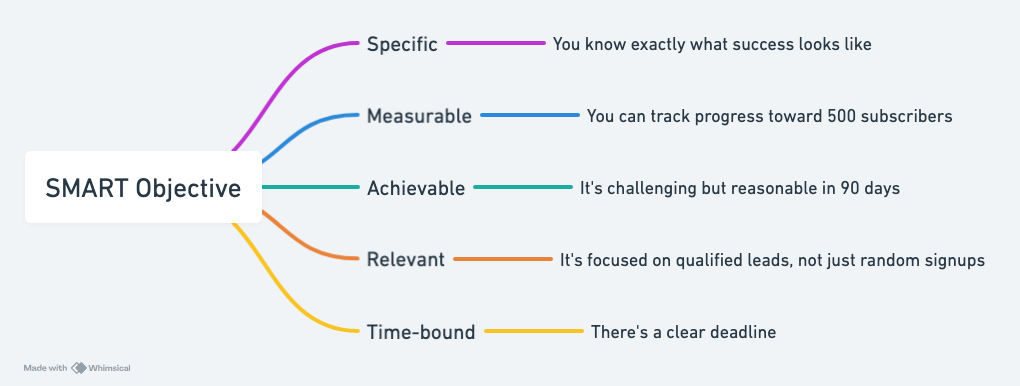Your cart is currently empty!

For Effective Marketing – Start at the End
Use SMART Objectives to Sharpen Your Marketing Plan
Reading Time: 7 minutesStalled Growth? You’re Not Alone
You’ve hustled hard. You’ve tested different approaches. Your scrappy marketing efforts have helped you grow. But something’s happened—your business has hit a plateau.
Sound familiar?
I see this all the time with business owners who’ve successfully reached that high six-figure or low seven-figure revenue mark. The DIY marketing approach that got you here won’t get you where you want to go next. Scaling beyond your current level requires something more structured than random tactics and hoping for the best.
Spray and pray is not a strategy – James’ism
To change, ironically, you need to start at the end. You need to start with the objective.
But before we get too far down the road, let’s define our terms.
Understanding the Hierarchy: Mission, Vision, and Objectives
I find many business owners use these terms interchangeably, which creates confusion. When you understand the hierarchy, your communication to the marketplace and your team improves.
Mission Statement – This is your company’s purpose, the reason you exist. It’s broad, inspirational, and typically doesn’t change much over time. Think of it as your North Star.
For example, Inn8ly’s Mission Statement is: “To help business owners break through marketing noise and achieve predictable growth.”
Vision Statement – This is where you want your company to be in the future. It’s aspirational and paints a picture of what success looks like 5-10 years from now.
Example: “To become the trusted digital marketing partner for 500 growth-oriented businesses by 2030.”
SMART Objectives – These are the specific, measurable milestones that move you toward your vision while fulfilling your mission. They’re tactical, time-bound, and change as you achieve them.
Example: “Increase qualified lead generation by 25% in Q2 through targeted content marketing.”
As Sun Tzu said, “Strategy without tactics is the slowest route to victory. Tactics without strategy is the noise before defeat.” Your mission and vision provide strategic direction, while your SMART objectives define the milestones that you need to reach to get there.
The key difference? Mission and vision statements inspire—they’re the “why” behind your business. Objectives drive action—they’re the “what,” “how,” and “when.”
Too many business owners try to use their mission statement as a measurement tool. That’s like trying to navigate a city with just a compass but no map. The compass (mission) tells you the general direction, but the map with specific routes (objectives) gets you to the exact location.
The Three-Legged Stool of Effective Marketing
Think of your marketing as a three-legged stool. Your SMART objective is the seat, but for it to stand properly, you need all three legs.

- Strategy – Who you’re talking to and why they’ll care
- Plan – How and when you’ll reach them
- Measurement – How you’ll know if it’s working
Our post, “What is a Marketing Strategy and Why Do I Need One,” digs into the marketing strategy, plan, and measurement. Check it out.
When I start working with a new client, I don’t immediately jump in and change everything. First, we need to understand what is happening with their current marketing efforts. To do this, we implement UTM tracking codes to measure their existing efforts accurately.
What I discover more often than not is eye-opening. Several things are common. Top of the list is that most business owners aren’t measuring what they’re doing at all. And if they are tracking something, it’s usually not important. They’re looking at vanity metrics that don’t connect to business outcomes.
Here’s the kicker: that third leg, measurement, can’t exist without an objective.
Efficiency is doing things right; efficacy is doing the right things.~ James’ism
Without a clearly defined goal, what exactly are you measuring against? How can you tell if you’re making meaningful progress or just keeping busy?
👉 This is where I see many business owners struggle. They’re constantly running campaigns and checking analytics, but they have no idea if they’re actually winning.
In our post, Campaign Testing – 7 Things to Know, you can learn more about measurement.
Strategy, Plan, Objective—What Goes Where?
This measurement problem points to a more fundamental issue: the order of operations is wrong.
Let me break it down for you:
- Objective = the destination (Where do you want to end up?)
- Strategy = the compass (Who are you targeting + why will they care?)
- Plan = the road map (How and when will you reach them?)
The SMART objective comes first. It gives your strategy direction and your plan focus.
Without it? You’re doing a lot, but achieving very little. It’s like you are standing on the roof of your building, shouting at the world about what you do. Are you making some noise? Yes, you’re doing that, but is the shouting going to get you to your destination? Probably not.
The Origin of SMART (And Why It Still Works)
Back in 1981, George T. Doran introduced the SMART framework in his paper “There’s a S.M.A.R.T. Way to Write Management’s Goals and Objectives.”
Why?
Because he noticed that businesses that set fuzzy goals like “do better” or “increase sales” got fuzzy results. He knew they needed something more concrete, so he outlined five essential criteria:
- Specific – Be crystal clear about what you’re trying to accomplish
- Measurable – Use concrete numbers to define success
- Achievable – Set a goal you can realistically hit (with effort)
- Relevant – Make sure it connects to your broader business goals
- Time-bound – Put a deadline on it
It’s been over four decades, and guess what? The framework still holds up because it addresses a fundamental human tendency: we achieve what we define. And it’s not just for business objectives. You can also use SMART Objectives to improve your marketing efforts. Let’s talk about that.
SMART Template
| Element | Guiding Question | Answer |
|---|---|---|
| Specific | What exactly do I want to achieve? | Your answer here… |
| Measurable | How will I track progress or know it’s done? | Your answer here… |
| Achievable | Is this realistic given my resources and time? | Your answer here… |
| Relevant | Does this align with my long-term vision? | Your answer here… |
| Time-bound | What’s the deadline? | Your answer here… |
What a SMART Marketing Objective Looks Like
Let’s look at an example to make this practical.
Not SMART: “We want to grow our email list.”
(How much growth? By when? For what purpose? This gives your team virtually nothing to work with and you nothing to measure. (More on this below.)
SMART: “Grow our email list by 500 qualified subscribers in the next 90 days by offering a downloadable guide to small business owners.”
Components of a SMART Marketing Objective

Specific – You know exactly what success looks like
Measurable – You can track progress toward 500 subscribers
Achievable – It’s challenging but reasonable in 90 days
Relevant – It’s focused on qualified leads, not just random signups
Time-bound – There’s a clear deadline
With this SMART objective in place, your team knows what to do, why it matters, and how to track success. The guesswork disappears, and you have an anchor for your marketing strategy and plan, which leads to more effective marketing.
“Unless commitment is made, there are only promises and hopes; but no plans.” ~ Peter Drucker
SMART Use Case
Let me share a quick example of how this plays out in real life. We worked with a client who was spreading themselves too thin, trying to maintain active profiles on six different social media platforms while also juggling email marketing, content creation, and paid ads.
When we established their SMART objective (“Generate 20 qualified sales calls per month from digital channels within 90 days”), something interesting happened. We had permission to make tough decisions about the tactics. They realized that three of their social platforms were producing zero leads, so they paused those efforts and redirected that time and budget to the channels that were working. Within 60 days, as a result of a more effective marketing plan, they’d hit their objective, and they were working fewer hours on marketing.
That’s the power of starting with a clear SMART objective. It’s not just about knowing what to do—it’s about knowing what NOT to do.
When the Objective Is Clear, the Plan Gets Smarter

Once you have a SMART objective, everything else falls into place. You can:
- Prioritize the right tactics (not just what’s trendy)
- Allocate your budget wisely
- Communicate expectations clearly to your team
- Track real progress, not vanity metrics
- Adjust the course when needed without losing sight of the destination
It’s also dramatically more cost-effective. With a SMART objective in place, you know exactly where to spend your precious marketing dollars and, just as importantly, where NOT to spend them. No more throwing money at tactics that “might” work. No more vanity metrics. Instead, you invest strategically in the channels and methods that directly support your objective.
“Being specific about what you want and how you will measure it will save you time, money, and heartache.” ~ Seth Godin
Plus, you finally have the metrics to measure true ROI. You can see clearly which marketing efforts are paying off and which ones are draining your resources without results. This level of clarity leads to better decisions and a more efficient marketing budget.
Start with the End in Mind

The most scalable marketing strategies don’t start with tactics or the latest platform. They start with outcomes.
If you want to grow beyond your current plateau, get crystal clear on where you’re going first. A SMART objective sets the stage for focused strategy, efficient tactical execution, and meaningful measurement.
Want to discuss setting SMART objectives for your business further? Go to VIPChatwithJames.com and book a virtual coffee. I love chatting with business owners about their marketing challenges.
SMART Objectives – The FAQs
Where should I start—strategy, plan, or objective?
Start with the objective. It sets the direction for your strategy and gives focus to your plan. Without a clear end goal, you risk wasting resources on tactics that don’t move the needle.
How do SMART objectives improve marketing ROI?
SMART objectives clarify your goals, streamline decision-making, and reduce wasted spend. They help you prioritize the right tactics, track actual progress, and eliminate guesswork, making your marketing more effective.
Can SMART objectives help fix stalled growth?
Yes. When growth stalls, it’s often because your marketing has become reactive. SMART objectives create clarity, helping you focus on what matters and identify which activities will move your business forward.
Related Posts
-
Marketing Strategy Mistakes to Avoid
Discover the 12 common marketing strategy mistakes that can hinder growth.
-
Your Marketing – A Pile of Parts or a Wheel?
Your marketing isn’t missing effort—it’s missing connection. Making connections turns scattered tactics into momentum.
-
SMART Objectives for Effective Marketing
A SMART objective sets the stage for success. And it give your measurement a backbone.
Author: James Hipkin
Since 2010, James Hipkin has built his clients’ businesses with digital marketing. Today, James is passionate about websites and helping the rest of us understand online marketing. His customers value his jargon-free, common-sense approach. “James explains the ins and outs of digital marketing in ways that make sense.”
Use this link to book a meeting time with James.

